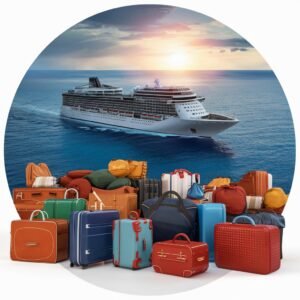The right luggage for your cruise travel will make your travel easy so choose it perfectly and pack smartly, you can ensure a stress-free and enjoyable vacation at sea.
When planning baggage for a cruise, it’s important to consider a mix of practicality, organization, and style. Here’s a guide to help you pack effectively:
1. Types of Bags and Luggage
1.1. Checked Luggage
- Description: These are larger suitcases or duffel bags that you’ll check in at the cruise terminal. They are delivered to your cabin after boarding.
- Size and Capacity: Choose a suitcase or duffel bag that can hold your clothing, shoes, and other essentials for the duration of the cruise. A 25-30 inch suitcase is typically adequate for most cruises.
- Considerations: Make sure your checked luggage is durable, with strong zippers and handles, as it will be handled multiple times by porters and crew members.
1.2. Carry-On Bag
- Description: A smaller bag or backpack that you keep with you when boarding. It should contain essentials and valuables.
- Essentials to Pack: Travel documents, medications, electronics, toiletries, a change of clothes, and any items you may need before your checked luggage arrives at your cabin.
- Size: It should be small enough to carry comfortably but large enough to hold everything you’ll need for the first few hours onboard.
1.3. Day Bag or Backpack
- Description: This is a versatile bag for daily use during the cruise, especially for shore excursions.
- Usage: Carry items like sunscreen, water, camera, identification, and any other essentials you need while exploring ports of call.
- Features: Look for a bag that’s lightweight, durable, and preferably water-resistant.
1.4. Formal Wear Garment Bag
- Description: If your cruise includes formal nights, a garment bag is useful for transporting formal wear, like suits, dresses, and other wrinkle-prone clothing.
- Benefits: Helps keep your formal wear organized and wrinkle-free.
1.5. Laundry Bag
- Description: A collapsible bag for storing dirty laundry during the cruise.
- Usage: Helps keep your cabin organized and makes it easier to manage laundry by the end of the trip.

2. Packing Tips for Port Immigration
2.1. Important Documents and Valuables
- Documents: Always keep your passport, visa (if required), cruise tickets, and any other essential travel documents in your carry-on bag.
- Port Immigration: You may need to present these documents at various points during your cruise, particularly when disembarking in foreign ports.
- Valuables: Carry valuables like jewelry, electronics, and cash in your carry-on to ensure they are secure and easily accessible.
2.2. Customs and Security Considerations
- Packing for Security: Ensure that your luggage is packed in a way that allows for easy inspection. Avoid overpacking and consider using clear bags for liquids and electronics.
- Prohibited Items: Check the cruise line’s list of prohibited items to avoid issues during security checks. Items like weapons, alcohol (unless purchased on board), and certain electronics may be restricted.
2.3. Shore Excursions and Reboarding
- Day Bags: When disembarking for shore excursions, pack a day bag with essentials such as identification (passport or ship ID card), money, sunscreen, water, and any necessary medications.
- Reboarding: Keep in mind that security screenings are common when reboarding the ship after visiting ports, so pack items that are easily accessible for inspection.
Packing Essentials:
I have a complete packing list for sea travel. Please check here.
3. Luggage Handling and Porters
- Porter Services: Upon arriving at the cruise terminal, porters are available to assist with your checked luggage. These bags will be tagged and delivered to your cabin later in the day.
- Tipping: It’s customary to tip porters, usually around $1-2 per bag.
4. Special Considerations
4.1. International Ports of Call
- Customs Declarations: Be aware of the customs regulations for each country you visit. Some items may be restricted or require declaration when you reboard the ship.
- Currency and Language: Depending on the ports you visit, consider carrying a small amount of local currency and learning key phrases in the local language for smoother interactions.
4.2. Packing for Different Climates
- Layering: Pack clothing that can be layered to accommodate varying temperatures, especially if your cruise travels through different climate zones.
- Special Gear: If your cruise includes outdoor activities, such as hiking or snorkeling, pack appropriate gear or attire.
5. Organizing Your Luggage
- Packing Cubes: These help keep your clothes organized and make it easier to find items in your suitcase.
- Garment Bag: For formal wear, a garment bag prevents wrinkles and keeps your outfits in good condition.
- Waterproof Bag: For beach or pool days, a waterproof bag can keep your belongings dry and safe.

6. Security
- Luggage Locks: Use TSA-approved locks to secure your luggage.
- Luggage Tags: Make sure your luggage has sturdy tags with your contact information in case it gets lost.
7. Prohibited Items
- Check your cruise line’s list of prohibited items to avoid bringing anything that could be confiscated (like irons, candles, or certain types of beverages).
8. Embarkation Day Essentials
- Pack a carry-on with essentials for the first day (swimsuit, a change of clothes, medications, etc.), as your checked luggage might not arrive at your cabin until later in the day.

Additional Tips:
- Port Days: Bring a collapsible day pack or tote for excursions.
- Beach Gear: If your cruise includes beach destinations, pack lightweight beach gear (e.g., a quick-dry towel, snorkel gear, or a beach mat).

When preparing for a cruise, packing the right luggage is essential to ensure you have everything you need for a comfortable and enjoyable voyage.


